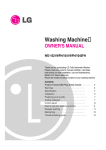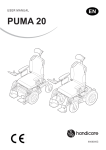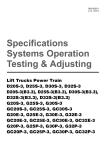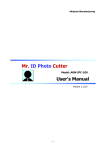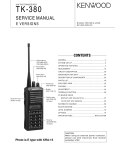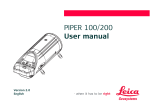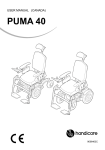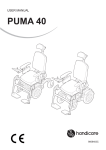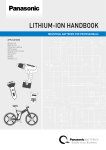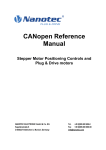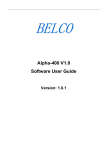Download Service Manual - Doosan Infracore
Transcript
SB2013E02 May. 1 9 9 8 Service Manual Diesel Engine 3.3 Liter (DB33A) Important Safety Information Most accidents involving product operation, maintenance and repair are caused by failure to observe basic safety rules or precautions. An accident can often be avoided by recognizing potentially hazardous situations before an accident occurs. A person must be alert to potential hazards. This person should also have the necessary training, skills and tools to perform these functions properly. Read and understand all safety precautions and warnings before operating or performing lubrication, maintenance and repair on this product. Basic safety precautions are listed in the ÒSafetyÓ section of the Service or Technical Manual. Additional safety precautions are listed in the ÒSafetyÓ section of the owner/operation/maintenance publication. Specific safety warnings for all these publications are provided in the description of operations where hazards exist. WARNING labels have also been put on the product to provide instructions and to identify specific hazards. If these hazard warnings are not heeded, bodily injury or death could occur to you or other persons. Warnings in this publication and on the product labels are identified by the following symbol. WARNING Improper operation, lubrication, maintenance or repair of this product can be dangerous and could result in injury or death. Do not operate or perform any lubrication, maintenance or repair on this product, until you have read and understood the operation, lubrication, maintenance and repair information. Operations that may cause product damage are identified by NOTICE labels on the product and in this publication. DAEWOO cannot anticipate every possible circumstance that might involve a potential hazard. The warnings in this publication and on the product are therefore not all inclusive. If a tool, procedure, work method or operating technique not specifically recommended by DAEWOO is used, you must satisfy yourself that it is safe for you and others. You should also ensure that the product will not be damaged or made unsafe by the operation, lubrication, maintenance or repair procedures you choose. The information, specifications, and illustrations in this publication are on the basis of information available at the time it was written. The specifications, torques, pressures, measurements, adjustments, illustrations, and other items can change at any time. These changes can affect the service given to the product. Obtain the complete and most current information before starting any job. DAEWOO dealers have the most current information available. TO THE CUSTOMERS This operation and maintenance manual is designed to serve as a reference for DHI's customers and distributors who wish to gain basic product knowledge on DHI's DB33 Diesel engine. To maintain the engine in optimum condition and retain maximum performance for a long time, CORRECT OPERATION and PROPER MAINTENANCE are essential. In this manual, the following symbols are used to indicate the type of service operations to be performed. Removal Adjustment Installation Cleaning Disassembly Pay close attention-Important Reassembly Tighten to specified torque Align the marks Use special tools of manufacturer's Directional Indication Lubricate with oil Inspection Lubricate with grease Measurement If you have any question or recommendation in connection with this manual, please do not hesitate to contact our head office, dealers or authorized service shops. CONTENTS 1. GENERAL INFORMATIONS 1.1. General Repair Instructions 1.2. Engine Specifications 1.3. Torque Specifications 1 1.4. Major Parts Fixing Bolts 1.5. Engine Repair Kit 1.6. Repair 2. ENGINE ASSEMBLY 2.1. General Description 2.2. Disassembly 19 2.3. Inspection and Repair 2.4. Reassembly 3. LUBRICATING SYSTEM 3.1. General Description 3.2. Oil Pump 61 3.3. Oil Filter 3.4. Oil Cooler 4. COOLING SYSTEM 4.1. General Description 4.2. Water Pump 66 4.3. Thermostat 5. FUEL SYSTEM 5.1. General Description 5.2. Fuel Filter 6. SPECIAL TOOL LIST • WORLDWIDE NETWORK 70 5.3. Injection Nozzle 74 1. GENERAL INFORMATION 1.1. General Repair Instructions 1. For safety, park the truck on even ground or work station and fix the wheels using wedges and hand brake during operation. 2. Before performing service operations, disconnect the grounding cable from the battery to reduce the chance of cable damage and burning due to short-circuiting. 3. Before performing service operations release the air pressure in the machine air line system for safety. To not do so is extremely dangerous. 4. Use covers to prevent the components from damage or pollution. 5. Brake oil and anti-freeze solution must be handled with reasonable care as they cause paint damage. 6. The use of proper tools and special tools where specified is important for efficient and reliable service operation. 7. Use genuine DAEWOO parts exclusively. 8. Used cotter pins, gaskets, O-rings, oil seals, lock washers and self-lock nuts should be discarded and new ones should be prepared for installation as normal function of the parts can not be maintained if these parts are reused. 9. To facilitate proper and smooth reassembly operation, keep disassembled parts neatly in groups. Keeping bolts and nuts separate is very important as they vary in hardness and design depending on the position of installation. 10. Clean the parts before inspection or reassembly. Also clean oil ports, etc. using compressed air to make certain they are free from restrictions. 11. Lubricate rotating and sliding faces of parts with oil or grease before installation. 12. When necessary, use a sealant on gaskets to prevent leakage. 13. Carefully observe all specifications for bolts and nuts torques. 14. When a service operation is completed, make a final check to ensure that the service has been done properly. 1 1.2. Engine Specifications Engine Model Items DB 33A Engine type Water-cooled, 4 cycle in-line, overhead valve type Combustion chamber type Direct injection type Cylinder liner type Dry type, casting liner Timing gear system Gear drive type No. of piston ring Compression ring 2, oil ring 1 No. of cylinder-bore¡¿stroke (mm) Total piston displacement 4-102¡¿100 (cc) 3,268 Compression ratio (199 cu in) 17.5 : 1 Engine dimension(length¡¿width¡¿height) Engine weight(dry) (mm) 795¡¿701¡¿720 (kg) 340 (31¡¿28¡¿28 in) (750 lbs) Fuel injection order 1-3-4-2 Fuel injection timing(B.T.D.C static) 13¡˘ Type of fuel used High-speed diesel fuel (SAE No.2) Injection pump type VE Governor type Mechanical governing Injection nozzle type (DOOWON) Multi-hole type (6 hole) - VCO nozzle Fuel injection pressure (Kg/cm ) 220 Compression pressure (kg/cm ) 30 (at 200 RPM) Low idle speed (R.P.M) 775-825 High idle speed (R.P.M) 2400-2500 2 2 Intake and exhaust valve clearance(at cold) Intake valve Exhaust valve (mm) (3,128 psi) (426 psi) 0.4 Open at 28 (B.T.D.C) Close at 62 (A.B.D.C) Open at 70 (B.B.D.C) Close at 28 (A.T.D.C) Lubrication method Pressurized circulation Oil pump type Gear type Oil filter type Full-flow type Lubricating oil capacity (§⁄) 7.5 (Oil pan) (1.97 gal) Oil cooler type Water cooled Cooling method Pressurized circulation Cooling water capacity(engine only) (§⁄) 7.5 (1.97 gal) Thermostat type Wax pallet type (with jiggle valve) Generator voltage-capacity(V-A) 12-61 Starter Voltage-output(V-KW) 12-2.5 2 1.3. Torque Specifications ¡ Standards bolts The torque values given in the following table should be applied where a particular torque is not specified. (Unit : kgƒUm) Bolt identification Bolt diameter¡¿pitch 4T Low carbon steel 7T High carbon steel 6¡¿1.0 0.4-0.8 0.5-1.0 - 8¡¿1.25 0.8-1.8 1.2-2.3 1.7-3.1 10¡¿1.25 2.1-3.5 2.8-4.7 3.8-6.4 2.0-3.4 2.8-4.6 3.7-6.1 12¡¿1.25 5.0-7.5 6.2-9.3 7.7-11.6 ¡ 12¡¿1.75 4.6-7.0 5.8-8.6 7.3-10.9 14¡¿1.5 7.8-11.7 9.5-14.2 11.6-17.4 ¡ 14¡¿2.0 7.3-10.9 9.0-13.4 10.9-16.3 16¡¿1.5 10.6-16.0 13.8-20.8 16.3-24.5 ¡ 16¡¿2.0 10.2-15.2 13.2-19.8 15.6-23.4 18¡¿1.5 15.4-23.0 19.9-29.9 23.4-35.2 20¡¿1.5 21.0-31.6 27.5-41.3 32.3-48.5 22¡¿1.5 25.6-42.2 37.0-55.5 43.3-64.9 24¡¿2.0 36.6-55.0 43.9-72.5 56.5-84.7 ¡ 10¡¿1.5 9T Alloy steel The ¡ indicates that the bolts are used for female-threaded parts that are made of soft materials such as casting, etc. 3 1.4. Major Parts Fixing Bolts ¡ Cylinder head and block (unit : kgƒUm) 2.5 2.1 18.0 lb¡⁄ft 15.2 lb¡⁄ft 72.32 lb¡⁄ft 10.0 11.5 83.17 lb¡⁄ft 5.3 38.33 lb¡⁄ft 4 ¡ Intake and exhaust manifold (unit : kgƒUm) 2.1 15.2 lb¡⁄ft 2.1 15.2 lb¡⁄ft 5 ¡ Cylinder block and others (unit : kgƒUm) 13.7 99.1 lb¡⁄ft 2.6 18.8 lb¡⁄ft Lubricate with engine oil 2.1 15.2 lb¡⁄ft 7.9 57.0 lb¡⁄ft 2.6 18.8 lb¡⁄ft 2.4 Lubricate with engine oil 6 ¡ Cylinder block and others (unit : kgƒUm) 2.6 18.8 lb¡⁄ft 2.6 18.8 lb¡⁄ft 5.3 38.3 lb¡⁄ft 2.6 5.3 38.3 lb¡⁄ft 7 18.8 lb¡⁄ft ¡ Crankshaft and camshaft (unit : kgƒUm) 44.0 318 lb¡⁄ft 9.75¡ 0.25 70.5 ¡ 1.8 lb¡⁄ft 12¡ 0.25 86.8 ¡ 1.8 lb¡⁄ft 16.0 115.7 lb¡⁄ft 5.5 39.8 lb¡⁄ft 2.5 18.1 lb¡⁄ft 16.0 115.7 lb¡⁄ft 8 ¡ Thermostat and housing (unit : kgƒUm) 2.1 10.5 lb¡⁄ft 5.3 25.1 lb¡⁄ft 9 1.5. Engine Repair Kit Part No. 1¡›25 : Engine disassembly components Part No. 1, 3, 21, 22, 25 : Engine top disassembly components 1. Gasket : Cylinder head 2. Gasket : Cylinder head cover and bolt 3. Gasket : Head cover 4. Gasket : Relief valve 5. Gasket : Injection pump 6. Gasket : Tappet chamber and bolt 7. Gasket : Oil cooler 8. Gasket : Oil pump cover 9. Oil seal : Crankshaft(RR) 10. Gasket : Retainer 11. Gasket : Case and cylinder block 12. Gasket : Cover and case 13. Gasket : Oil pan drain plug 14. Gasket : Oil pan and body 15. Gasket : Oil filter 16. Gasket : Oil pump and pipe 17. Gasket : Oil filter pipe 18. Gasket : Oil jet pipe 19. Gasket : Water pump 20. Gasket : Outlet pipe 21. Gasket : Thermostat housing 22. Gasket : Nozzle gasket 23. Oil seal : Crank gear case 24. Gasket : Exhaust manifold 25. Gasket : Injection nozzle 10 1.6. Repair 1.6.1. Cylinder Head Bolt Tighten the cylinder head bolts in sequence as shown in the figure. Torque(kgƒUm) 11.5 ( 83.2 lb¡⁄ft) Front 1.6.2 Valve Clearance Adjust the valve clearance in the following manner using a feeler gauge. Standard(in cold) Intake and exhaust (mm) 0.4 (.016 in) 1. Bring the piston in either the No. 1 cylinder or the No. 4 cylinder to top dead center on the compression stroke by turning the crankshaft until the TDC notched line on the crankshaft pulley is aligned the timing pointer. 2. Check to see if there is play in the No. 1 intake and exhaust valve rocker arms. If the No. 1 cylinder intake and exhaust valve rocker arms are depressed, the No. 4 piston is at TDC on the compression stroke. TDC The same results can be obtained by using the TDC line on flywheel and pointer. TDC line 11 Timing pointer Adjust the clearances of valves marked with an arrow Rocker arm screw lock nut torque (kgƒUm) 2.5 (18.1 lb¡⁄ft) After adjusting the valve clearances referring to the drawing, turn the crankshaft one full turn in the rotative direction and align the TDC mark with the pointer, then adjust the remaining valve clearances. 1.6.3. Injection Timing Inspection Check the notched line on the crankshaft pulley and timing pointer are aligned. Setting Timing (BTDC) Engine : 13¡B̆TDC I/P : Plunger Lift 0.3mm (.0118 in) TDC Remove the inspection hole cover at the front of gear case cover. Check the alignment between the notched line on the camshaft gear and the arrow mark of gear case cover. Notched line Arrow mark Check the notched line on the injection pump is in alignment with the notched line on the timing gear cover. Arrow mark Check the alignment of the notched lines injection pump and bracket. Notched line Notched line 12 Injection timing adjustment 1. Adjust fuel injection timing with crank pulley notched line and timing pointer. Adjust the timing pointer with the marking on the pulley. TDC Disconnect the inj. pipes (4pieces) from I/P 2. Remove 2 fixing bolts of timing flange and injection pump. Remove bolt located at the center. Insert the dial gauge to check the plunger lift. 3.Turn the timing flange to adjust the plunger lift to 0.3mm. 13 4. Install the No. 1 injection pipe and tighten to specified torque. Injection pipe nut torque (kgƒUm) 3¡›3.5 (21.7~25.3 lb¡⁄ft) Do not overtighten the delivery valve holder. It will distort the injection pump body shape and adversery affect control rack operation. 1.6.4. Compression Pressure Remove the glow plugs from all cylinders, then check the compression pressure in each cylinder with a compression gauge by engaging starter. (kg/cm2, 200 rpm) Standard Limit 30 22¡›23 (312~327 psi) Compression gauge adapter Compression gauge adapter 1.6.5. Air Cleaner Dry type air cleaner ¡ Observe the air cleaner service indicator ¡ Clean the air cleaner element and dust pan when the RED band in the service indicator looks in the visible position. Air cleaner service indicator Stop button Cleaning primary filter element Direct air inside of the element and blow out dusts from the pleats completely. (Maximum air pressure does not excess 2.1kg /cm2) ¡ Always replace the secondary element. Do not attempt to reuse it by cleaning. ¡ 14 Detergent ¡ Wash the element in warm water and nonsudsing household detergent. ¡ Rinse the element with clean water ¡ Dry it thoroughly with natural air or electric fan. Don't use a flame or compressed air for drying. It damages the element. Checking element ¡ Insert a light inside the clean and dry element and examine it. ¡ Discard the element if tears, rips or damages are found. ¡ Wrap and store good elements in a clean, dry place. 1.6.6. Radiator Install the radiator cap tester and pressurize the radiator. ¡ Inspect the cooling system if there any leak. ¡ Measuring pressure (kg/cm2) 1.0 (14.2 psi) Radiator cap Pressure valve opening pressure (kg/cm2) 0.87 (12.4 psi) Vaccum valve opening pressure (kg/cm2) 0.05 (.71 psi) 1.6.7. Lubricating System Oil filter replacement ¡ Before installing a new filter element apply a small amount of clean engine oil to the element gasket. ¡ Install the new element. When the gasket contacts the base, tighten it 3/4 of a turn more. Do not overtighten. 15 Element 1.6.8. Fuel System Injection nozzle Check the spraying condition and injection starting pressure. Injection starting pressure (kg/cm2) Correct Incorrect Incorrect 220 (3.128 psi) Adjustment Adjust the injection starting pressure with the adjusting screw using a nozzle tester. 1.6.9. Fan Belt Fan pulley (mm) Specified belt deflection Depress here 10 (.393 in) Generator pulley Crank pulley 1.6.10. Glow Plug Inspection(Resistance) Silver color 4.5 § Black color 1.6§ Check the continuity across the plug terminals and body. 16 2. Engine Assembly 2.1. General Description 17 2.2. Disassembly 2.2.1. External Parts (A) 11 8 6 5 12 11 8 1 2 3 9 6 10 5 4 7 <Disassembly steps> 1. Breather hose 2. Exhaust manifold 3. Oil guide tube and level gauge 4. Starter 5. Cooling fan belt 6. Alternator 7. Oil pan 8. Cylinder head cover 9. Rubber hose 10. Water pump 11. Thermostat housing assembly 18 Important operations ¡ Exhaust manifold assembly(2) Loosen the manifold fixing bolts in sequence of figure's shown. 1 8 3 ¡ 5 6 4 7 2 Cylinder head cover(8) Loosen the head cover bolts in sequence of figure's shown 1 19 3 2 2.2.2. External Parts (B) 4 8 1 7 6 5 2 3 8 6 <Disassembly steps> 1. Fuel injection pipe 2. Injection nozzle 3. Glow plug 4. Intake manifold 5. Oil pipe 6. Oil filter assembly 7. Injection pump 8. Oil cooler assembly 20 Important operations ¡ Engine control cable. Disassemble the engine control cable. ¡ Injection nozzle(2) Avoid damaging the nozzle tips or other parts during disassembly. ¡ Injection pump assembly(7) When disassembving the injection pump, cap or tape the delivery valve holder to avoid dirt entry. 21 2.2.3. Internal Parts ¡ Major Components <Disassembly steps> 1. Rocker arm shaft assembly 2. Push rod 3. Cylinder head assembly 4. Cylinder head gasket 5. Fly wheel 6. Fly wheel housing 7. Rear oil seal assembly 8. Oil pump cover 9. Oil pump assembly 10. Piston and connecting-rod assembly 11. Crankshaft front nut and washer 12. Crankshaft pulley 13. Gear case cover 14. Idle gear 15. Camshaft assembly 16. Timing gear case 17. Crankshaft bearing cap and bearing 18. Thrust bearing 19. Crankshaft assembly 20. Crankshaft bearing 21. Tappet 22 Important operations ¡‹ Rocker arm shaft assembly (1) Loosen the rocker arm shaft assembly bolts a little at a time in numerical sequence as shown in the figure. ¡‹ Cylinder head assembly (3) Loosen the cylinder head bolts a little at a time in the numerical sequence as shown in the figure. Front ¡‹ Flywheel (5) Loosen the flywheel bolts a little at a time in numerical sequence as shown in the figure. Apply engine oil ¡‹ Piston assembly (10) Remove any carbon deposits from the upper part of the cylinder bore using a scraper. This will prevent damage to the piston and the piston rings when they are removed from the cylinder bore. Position the piston to the top by turning the crankshaft, remove the piston assembly from cylinder using a wooden bar or hammer. 23 ¡‹ Crankshaft front nut and washer (11) Wrench : 41 mm Wrench ¡‹ Idle gear (14) Measure the following points before disassembly. Idle gear end play. (mm) Standard Limit 0.058¡›0.115 (.002~0.0045 in) 0.2 (.0078 in) Feeler gauge Backlash (mm) Standard Limit 0.10¡›0.17 (.0039~.0069 in) 0.3 (.012 in) Includes the crankshaft gear, camshaft gear and idle gear. Dial indicator ¡‹ Crankshaft bearing cap and bearing (17) Measure the crankshaft end play before disassembly. Crankshaft end play Feeler gauge (mm) Standard Limit 0.10¡›0.17 (.0039~.0067 in) 0.3 (.012 in) Includes the crankshaft gear, camshaft gear and idle gear. Crankshaft Loosen the crankshaft bearing cap bolts in numerical sequence as shown in the figure. Apply engine oil 24 ¡‹ Thrust bearing (18) Remove the thrust bearing with steel wire. Wire ¡‹ Tappet (21) Remove the tappets and mark the cylinder number each tappet. (Be careful against the damages) Mark the cylinder No Exhaust 2.2.4. General Components ¡ ‹ Rocker arm, Bracket and shaft assembly <Disassembly steps> 1. Bracket 2. Rocker arm 3. Spring 4. Rocker arm shaft 25 Intake ¡ Cylinder head assembly <Disassembly steps> 1. Spring retainer and valve cotter 2. Spring and spring seat 3. Valve 4. Valve stem oil seal Important operations Mark the cylinder No. each component when it disassembles. ¡ Valve spring ¡ Valve ¡ Valve seat ¡ Retainer and valve cotter (1) Spring compressor Valve spring compressor 26 ¡ Piston and connecting-rod assembly <Disassembly steps> 1. Piston ring 2. Snap ring 3. Piston pin and connecting-rod 4. Piston Important operations Mark the cylinder No. each component when it disassembles. ¡ ¡ ¡ ¡ 27 Piston ring Piston Piston pin Connecting-rod ¡‹Piston ring (1) Remove the piston rings ¡‹Snap ring (2) Remove the piston pin snap ring ¡‹ Piston pin and connecting-rod (3) Pull out the piston pin with brass bar 2.3. Inspection and Repair Make the necessary adjustments, repairs and replacements if excessive wear or damage is discovered during inspection. 2.3.1. Cylinder Head Lower face warpage a straight edge and a feeler guage to measure the four sides and the two diagonals of the cylinder head lower face. ¡‹ Use 28 Lower face warpage and height (mm) Standard Limit Warpage 0.05 or less (.002 in) 0.2 (.008 in) Thickness (reference) 89.95¡›90.05 (3.54~3.55 in) 89.75 (3.53 in) 2.3.2. Valve, Valve Guide and Valve Seat Insert Valve contact width (mm) Standard Limit 1.5 (.059 in) 2.0 (.079 in) Contact width Valve depression (mm) Standard Limit 1.0 (.039 in) 2.5 (.098 in) Depression Valve seat angle Valve seat angle Valve seat insert replacement Removal : Arc weld the entire inside circumference of the valve seat insert. ¡ ‹ Cooling the valve insert for a few minutes and pull out with a screw driver. Installation : Use a bench press to smoothly press the valve seat insert. Valve seat insert Cylinder head Welding bead 29 Valve seat angle Intake valve seat angle 45¡˘ Exhaust valve seat angle 45¡˘ 45¡˘ Valve seat angle (mm) Standard Limit 1.5 (.059 in) 1.0 (.039 in) Thickness Valve stem outer diameter (mm) Standard Standard Intake valve 8.946¡›8.961 (.352~.353 in) 8.88 (.350 in) Exhaust valve 8.921~8.936 (.351~.352 in) 8.88 (.350 in) Valve stem outer diameter ¥† ¥– ¥ (mm) Standard Standard Intake 0.04¡›0.07 (.002~.003 in) 0.2 (.008 in) Exhaust 0.06~0.09 (.002~.009 in) 0.25 (.010 in) Valve guide replacement Remover, installer Measuring point Remover, installer 30 2.3.3. Valve Spring Valve Spring Free Length Use a vernier caliper to measure the valve spring free length. If the measured value is less than the specified limit, the valve spring must be replaced. Standard Exhaust and Intake Valve Spring Free Length Free length Inner Outer 49.0 mm (1.93 in) 52.4 mm (2.06 in) 53.6 mm (2.11 in) Limit Remark for 47.0 mm (1.85 in) Industrial 50.0 mm for (1.97 in) Automotive 50.6 mm (1.99 in) Valve Spring Inclenation Use a surface plate and a square to measure the valve spring inclination. If the measured value exceeds the specified limit, the valve spring must be replaced. Valve spring Inclination Free length Inner Outer Standard less than 1.3 mm (.051 in) - Limit Inclination Remark for 2.7 mm (.106 in) Industrial 1.0 mm for (.039 in) Automotive 1.0 mm (.039 in) Free length Square Valve Spring Tension Use a spring tester to measure the valve spring tension if the measured value is less than the specified limit, the valve spring must be replaced. Standard Valve Spring 14.5 kg Tension at 40 mm (32 lbs) Set Length 10.9 kg 42mm Inner (1.65 in) (24 lbs) 23.0 kg 44mm Outer (1.73 in) (50.7 lbs) Limit Remark 11.5 kg for (25.4 lbs) Industrial 9.9 kg for (21.8 lbs) Automotive 20.0 kg (44.1 lbs) Spring tester 2.3.4. Tappet Inspect the tappets for excessive wear, damage and any abnormalities. Pitted Crack normal contact Abnormal contact 31 Diameter (mm) Standard Limit 27.97¡›27.98 (1.10 in) 0.2 (1.09 in) Micrometer Clearance between the tappet and cylinder body (mm) Standard Limit 0.02¡›0.054 (.0008~.002 in) 0.1 (.004 in) 2.3.5. Push Rod Run-out Limit (mm) 0.03 (.0012 in) ¡‹ Use a feeler gauge to measure the push rod run-out the push rod along a smooth flat surface as shown in the figure. ¡‹ Roll 2.3.6. Rocker Arm Shaft Assembly Inspect all disassembled parts for wear, damage and any abnormalities. Rocker arm shaft (mm) Standard Limit 18.98~19.00 (.747~.748 in) 18.85 (.742 in) 32 Dial indicator Rocker arm bushing (mm) Standard Limit 19.01~19.03 (.748¡›.749 in) 19.05 (.75 in) Clearance between rocker arm shaft and bushing (mm) Standard Limit 0.01¡›0.05 (.0004¡›.0020 in) 0.2 (.0079 in) 2.3.7. Camshaft Assembly Inspect all disassembled parts for wear, damage and any abnormalities. ¡‹ Camshaft Cam gear ¡‹ Thrust plate ¡‹ End play (mm) Standard Limit 0.050¡›0.114 (.0020¡›.0045 in) 0.2 (.0079 in) Camshaft gear Thrust plate Camshaft Feeler gauge Camshaft journal diameter (mm) Standard Limit 55.94¡›55.97 (2.202~2.204 in) 55.60 (2.189 in) 33 Run-out (mm) Standard 56.00¡›56.03 (2.205~2.206 in) Camshaft bearing Clearance between camshaft journal and body (mm) Standard Limit 0.03¡›0.09 (.001~.004 in) 0.15 (.006 in) Camshaft bearing replacement Remover, installer Remover, installer Align the camshaft oil holes with the cylinder body oil ports. The oil holes of No. 1 camshaft bearing(front side are two otherwise is one. Camshaft run-out (T.I.R) Standard Align the oil ports (mm) 0.1 (.004 in) ¡‹ Place the camshaft on a measuring stand. a dial indicator to measure the camshaft run-out ¡‹ Note the total indicator reading (T.I.R). ¡‹ Use Camshaft bearing Replace the camshaft gear if any damages or excessive backlash are found. Gear bolt torque (kgƒUm) 14.0 (101.3 lb¡⁄ft) 34 ¡ÿRefer to the standard backlash table at "Major components disassembly" Cam gear and thrust plate replacement Disassembly : Gear puller Install : Use a bench press and a hammer 16.0 (115.7 lb¡⁄ft) Torque (kgƒUm) Cam lobe height Cam lobe height (C) Cam journal diameter (A,B) Camshaft gear (mm) Standard Limit 47.7 (1.88 in) 56.0 (2.20 in) 46.5 (1.83 in) 55.6 (2.19 in) Use a micrometer to measure the cam lobe height and journal diameter. If the measured number is less than the specified limit, the camshaft must be replaced. 2.3.8. Idle Gear and Idle Gear Shaft Shaft outside diameter (mm) Standard Limit 44.94¡›44.97 (1.76~1.77 in) 44.84 (1.765 in) use a micro. Clearance between shaft and gear (mm) Standard Limit 0.009¡›0.060 (.0004~.0023 in) 0.2 (.008 in) 35 2.3.9. Cylinder Block and Liner For steel liner For cast liner Standard 105.00¡›105.04 (4.13~4.14 in) 105.99¡›106.01 (4.17~4.179 in) Limit 105.10 (4.14 in) 106.10 (4.18 in) Cylinder liner replacement Disassembly : Removeer Angle for steel liner only Angle Remover Installation Installer ¡‹ Use a bench press to apply an initial seating force of 500kg to the cylinder liner. ¡‹ And then apply a final seating force of 2,500kg to fully seat the cylinder liner. Steel liner Tight fit (standard) (mm) Cast liner Loose fit (mm) 20mm Cylinder bore measurement Measuring point : Approx. 20mm bellow from upper face(Maximum wear portion) (mm) Installer Bench press 0.001¡›0.019 (.0004~.0007 in) 0.005¡›0.026 (.0002~.0010 in) After installing the liner measure the cylinder liner projection and inner diameter. Square Liner projection Liner projection Standard (mm) 0.03¡›0.010 (.0011~.0004 in) ¡‹ For the cast liner, removal or installation is done easily. Feeler gauge 36 Cylinder liner inner diameter (mm) 102.021¡›102.040 (4.016~4.017 in) 102.041¡›102.060 (4.017~4.018 in) 102.021¡›102.030 (4.016~4.017 in) 102.031¡›102.042 (4.017 in) A For steel liner Standard C A For cast liner B 2.3.10. Piston, Piston Pin and Piston Ring Piston outer diameter (mm) Piston grade For steel liner Standard 101.955¡›101.975 (4.014~4.015 in) 101.975¡›101.994 (4.015~4.016 in) 101.953¡›101.967 (4.014~4.015 in) 101.963¡›101.977 (4.014~4.015 in) A C A For cast liner B Piston and liner bore clearance Standard (mm) 0.055~ 0.075 Piston ring Piston ring and ring groove clearance 1st compression ring 2nd compression ring Oil ring Standard Limit 0.085¡›0.11 (.003~.009 in) 0.035¡›0.055 (.001~.002 in) 0.03¡›0.07 (.001~.003 in) 0.2 (.008 in) 0.15 (.006 in) 0.15 (.006 in) Piston ring gap 1st compression ring 2nd compression ring Oil ring (mm) (mm) Standard Limit 0.25¡›0.45 (.010~.018 in) 0.2¡›0.4 (.008~.016 in) 0.2¡›0.4 (.008~.016 in) 1.5 (.006 in) 1.5 (.006 in) 1.5 (.006 in) 37 20mm Liner Grade Piston pin outside diameter (mm) Standard Limit 35.000¡›35.005 (1.377~1.378 in) 34.95 (1.376 in) Piston pin and piston clearance (mm) 0.005 (.0002 in) Limit (mm) 2.3.11. Connecting Rod and Bearing Connecting rod aligmment (parallelism) Alignment (per length of 100mm (3.94 in)) Standard Limit 0.05 (.002 in) 0.2 (.009 in) (mm) Bushing inside diameter Standard 35.017~35.025 (1.379 ~1.380 in) Use a caliper calibrator and micrometer to measure the piston pin and connecting rod small end bushing clearance. Piston pin and connecting rod small end bushing (mm) Standard Limit 0.01~0.03 (.0004~.0012 in) 0.05 (.002 in) 38 Bushing replacement Removal : Use a brass bar and a bench press Bench press Installation : Use a brass bar and a bench press. The connecting rod busing oil port must be aligned with the connecting rod oil port. After new bushing installation, ream the bushing inside diameter with a pin hole grinder or a reamer to fit the piston pin. Brass bar Pin hole grinder Reamer Connecting rod bearing Bearing spread Standard (mm) 68.00¡›68.01 (2.677~2.678 in) Bearing tension 1. Fit the connecting rod bearing lower half into the connecting rod bearing cap. 2. Check the connecting rod bearing lower half tension. If the tension is insufficient, the bearing must be replaced. 3. Reassemble the connecting rod and bearing cap. 2.3.12. Crankshaft and Bearing ¡‹ Crankshaft and bearing inspection 1. Inspect the crankshaft journal and pin surfaces for excessive wear and damage. 2. Inspect the oil seal fitting surfaces of the crankshaft front and rear ends for excessive wear and damage. 3. Replace or repair the crankshaft if any excessive wear or damage is found. 4. Inspect the crankshaft oil ports for obstructions. 5. Use high pressure air to clean the oil ports if necessary. 39 Crankshaft pin outside diameter ¤ 63.932¡›63.944 (2.517~2.517 in) Standard (mm) Use a micrometer to measure the crankshaft pin outside diameter across points ¤ and ¤Łat the two points ¤Øand ¤Œ. Connecting rod bearing cap reassembly Connecting rod bolt torque (kgƒUm) Bolt type A: 11 B: TY 11T 12¡ 0.25 9.75¡ 0.25 (86.7 ¡ 1.81 lb¡⁄ft) (70.51 ¡ 1.81 lb¡⁄ft) A B Bolt head or TY 12T Inside diameter - Apply engine oil to bearing surface. - Measure the connecting rod inside diameter with an inside dial indicator. Connecting rod bearing nominal diameter (mm) 64§j (2.52 in) Crankshaft pin and bearing clearance Standard Limit 0.03¡›0.07 (.001~.003 in) 0.10 (.004 in) Under size Bearing specifications (mm) (mm) 0.25¡›0.50 (.010~.020 in) Crankshaft journal bearing Tension Fit the journal bearing into the journal bearing cap and check the tension with the same method of connecting rod cap bearing. 40 ¤Ł ¤Ø¤Œ ¤Ł ¤ ¤Ø ¤Œ Crankshaft journal outside diameter B Use a micrometer to measure the crankshaft journal outside diameter across points £ and £ at the two points ¥ and ¥–. I II B 75.913¡›75.925 (2.989 in.) Standard (mm) B A Journal bearing cap reassembly 24 (173.6 lb¡⁄ft) Torque (kgƒUm) Inside diameter -Apply engine oil to bearing surface. -Measure the journal bearing cap inside diameter with an inside dial indicator. Journal bearing nominal diameter (mm) 76§j (2.992 in) Crankshaft journal and bearing clearance (mm) Standard Limit Center bearing 0.065¡›0.116 (.003~.006 in) 0.15 (.006 in) Other bearings 0.025~0.076 (.001~.003 in) 0.11 (.004 in) Under size Bearing specifications (mm) 0.25~0.50 (.010~.020 in) Crankshaft run-out (mm) Standard Limit 0.05 (.002 in) 0.40 (.016 in) 1. Mount the crankshaft on a set of v-blocks. 2. Set a dial indicator to the center of the crankshaft journal 3. Gently turn the crankshaft in the normal direction of engine rotation. 4. Read the dial indicator(TIR) as you turn the crankshaft. 41 Refer to "Major components disassembly" - Crankshaft bearing cap. Crankshaft gear Inspect the crankshaft gear - Before the gear disassembly, check the crank gear backlash. - If excessive wear of any damage is found through the inspection, replace the crankshaft gear. Crankshaft gear replacement Removal : Remover Refer to "Major components disassembly" - Gear backlash. Remover Installation Installer Installer Pilot bearing replacement Removal : remover Installation : Use a brass bar and hammer. 42 2.3.13. Flywheel and Housing(Rear Oil Seal) ¡ ‹Flywheel thickness (Friction face) (mm) Standard Limit 33.4¡›33.6 (1.315~1.323 in) 32.5 (1.280 in) Friction face Crankshaft assembly face Ring gear replacement Removal : Use a brass bar and hammer - Strike around the edges of the ring gear with a hammer and brass bar to remove it. Installation : -Heat the ring gear evenly with a gas burner to invite thermal expansion. Do not allow the temperature of the ring gear to exceed 200¡ (390¢ ) -Use a hammer to install the ring gear when it is sufficiently heated. Flywheel housing oil seal replacement Installer Removal : Use a pry bar and hammer. Installation : Use a oil seal installer. If the crankshaft contact area wears excessively, move the contact area with a oil seal spacer. Install new oil seal and discard the used one. Oil seal Spacer 43 2.3.14. Timing Gear Case Cover Oil seal replacement Installation : Installer Installer 2.4. Engine Reassembly 2.4.1. Minor Components ¡ ‹Piston and connecting-rod assembly 4 1 3 2 3 5 <Disassembly steps> 1. Piston 2. Piston pin 3. Snap ring 4. Piston ring 5. Connecting rod Important operation Piston heater ¡ ‹ Piston (1) Use a piston heater to heat the piston approximately 60¡ (140¢ ) 44 ¡ ‹ Piston pin and connecting-rod (2) 1. Install the connecting-rod to the piston with setting the marks as illustrated. Piston head Front mark 2. Install the piston pin into the piston and the connecting-rod bushing Cylinder numder marked side ¡ ‹ Snap ring (3) 1. Use a pair of snap ring pliers to install the piston pin snap ring. 2. Check that the piston moves smoothly on the piston pin. ¡ ‹Piston ring (4) 1. Use a piston ring installer to install the three piston rings. - Install the piston rings in the following order: oil ring ¤M2nd compression ring ¤M1st compression ring. FOR STEEL LINER 1st ring 2nd ring ¡ The marked side of the two compression rings must be facing up. The undercut side of the 2nd compression ring will be facing down. As the oil ring has no any facing mark, it may face in either direction. 2. Lubricate the piston ring surfaces with engine oil. 3. Check the piston ring rotate smoothly in the piston ring grooves. Marked side Oil ring FOR CAST LINER 1st ring 2nd ring 4. Use Cr-coating piston ring for cast liner and normal piston ring for steel liner. Oil ring 45 ¡ ‹ Cylinder head assembly 4 3 1 2 <Disassembly steps> 1. Valve stem oil seal 2. Valve 3. Spring seat and spring 4. Spring retainer and cotter key Important operation ¡ ‹ Valve stem oil seal (1) Installer Lubricate the oil seals and valve guides and install the oil seals with an installer. ¡ ‹ Intake and exhaust valves (2) 1. Lubricate valve stems with engine oil. Installer Intake valve Exhaust valve Big Small 2. Install the valves to the intake and exhaust guides. Install the valves to their original lapped valve seats. (Valve face) 46 ¡ ‹ Spring seat and spring (3) Install the valve springs with their painted end(the close pitched end) facing down. Painted portion ¡ ‹ Spring retainer and cotter key (4) Installer : Spring compressor - Use a spring compressor to push the valve spring into position. - Install the cotter key - Set the cotter key by tapping lightly around the head of the collar with a rubber hammer. Spring compressor 4 3 2 1 <Disassembly steps> 1. Bracket 2. Rocker arm 3. Spring 4. Rocker arm shaft 47 2.4.2. Internal Parts ¡ ‹ Major components 11 12 <Disassembly steps> 1. Tappet 2. Crankshaft bearing(upper) 3. Crankshaft 4. Thrust bearing 5. Crankshaft bearing cap and bearing(lower) 6. Timing gear case 7. Camshaft assembly 8. Piston and connecting rod assembly 9. Oil pump assembly 10. Oil pump cover 11. Oil cooler 12. Injection pump assembly 13. Idle gear 14. Timing gear case cover 15. Crankshaft pulley 16. Crankshaft front nut and washer 17. Flywheel housing 18. Rear oil seal assembly 19. Flywheel 20. Cylinder head gasket 21. Cylinder head assembly 22. Push rod 23. Rocker arm shaft assembly 48 Important operation With oil hole and groove Fit correctly ¡ ‹ Crankshaft bearing (upper) (2) ¡ ‹Crankshaft bearing (lower) (5) Center lower half bearing has no oil groove and oil hole while others all have oil groove and oil hole. No oil groove and hole (center lower) ¡ ‹Crank shaft (3) Install the crankshaft so that the crank gear assembled part is directed to the front of the engine. Front ¡ ‹ Thrust bearing (4) Oil groove side Install the thrust bearings with the oil groove side facing the crankshaft contact face. ¡ ‹ Crankshaft bearing cap - Lubricate the bearing cap bolts with engine oil - Install the bearing caps to the crankshaft. The arrow mark must be pointing to the front of the engine. Arrow mark(position No. punched) Front Tighten the bearing cap bolts to the specified torque a little at a time in the numerical order shown in the figure. Torque (kgƒUm) Arrow mark 24 (173.6 lb¡⁄ft) Check that the crankshaft turns smoothly by manually rotating it. Lubricate with enging oil 49 ¡ ‹ Timing gear case (6) 2.6 (18.8 lb¡⁄ft) Torque (kgƒUm) ¡ ‹ Camshaft (7) Tighten the thrust plate bolts through the camshaft gear hole. ¡ ‹Torque (kgƒUm) 2.1 (15.2 lb¡⁄ft) 16 (115.7 lb¡⁄ft) Thrust plate bolt Camshaft gear bolt Camshaft gear ¡ ‹Piston and connecting rod assembly (8) 2nd compression ring Position the piston ring gaps as shown in the figure. Oil ring Position the piston front mark towards the front of the engine. Use a hammer grip to push the piston in until it makes contact with the crank pin. At the same time, rotate the crankshaft until the crank pin reaches its highest point. Set the bearing cap cylinder number marks and the connecting-rod cylinder number marks. The marks must be facing the exhaust manifold. ¡ ‹ Connecting rod cap bolt Bolt head 11 TY 11T TY 12T Cylinder No. 12¡ 0.25 9.75¡ 0.25 (70.5 ¡ 1.8 lb¡⁄ft) (86.8 ¡ 1.8 lb¡⁄ft) -Lubricate the connecting-rod cap bolt threads and setting faces with MoS grease. Torque (kgƒUm) 50 Top ring ¡ ‹ Oil pump assembly(9) Full up the oil pump with engine oil and install the pump to the cylinder body. Oil Oil pump ¡ ‹ Oil pump mounting bolts Torque (kgƒUm) 3.8 (27.5 lb¡⁄ft) ¡ ‹ Oil cooler(11) Tighten the cooler bolts to the specified torque. Start from the middle and work out to either side. ¡ ‹Injection pump assembly (12) Torque (kgƒUm) 2.6 (18.8 lb¡⁄ft) "ƒU" ; Injection pump fixing bolts Check the punched line of the injection pump body is aligned to the pump bracket line. Arrow mark Notched line Notched line 51 ¡ ‹ Idle gear(13) Use the thrust collar fixing bolt as a guide to install the idler gear shaft. The oil port must be facing the camshaft. Set the timing marks (A,B,C) as shown in the figure. Injection pump gear Idle gaer Idle gear bolt Torque (kgƒUm) "B" mark 2.6 (18.8 lb¡⁄ft) "C" mark Crankshaft gear "A" mark Camshaft gear ¡ ‹ Crankshaft front nut (16) Pulley Wrench : 41 mm 2.6 (18.8 lb¡⁄ft) Torque (kgƒUm) Wrench ¡ ‹ Flywheel housing (17) Fixing bolts torque 14kgƒUm (101.25 lb¡⁄ft) ¡ ‹ Flywheel (19) Torque (kgƒUm) 16.0 (115.7 lb¡⁄ft) Lubricate with engine oil 52 ¡ ‹ Cylinder head gasket (20) The gasket "TOP" mark must be facing up and "FRONT" mark is towards the front of the engine. Front top mark Front ¡ ‹ Cylinder head assembly (21) Carefully place the cylinder head on the cylinder body. Lubricate the head bolts and contact face of the cylinder head. Tighten the head bolts in the numerical order as shown in the figure. 1st step 7.0 (50.6 lb¡⁄ft) 2nd step 11.5 (83.2 lb¡⁄ft) Front ¡ Shorter head bolts are used for injection pump side ¡ ‹ Rocker arm shaft assembly (23) Tighten the rocker arm bracket bolts to the specified torque a little at a time in the numerical order shown in the figure. Torque (kgƒUm) 3.1 (22.4 lb¡⁄ft) Adjust the valve clearance Refer to MAINTENANCE for the valve clearance adjustment procedure. 53 2.4.3. External parts (A) 11 8 6 5 7 11 8 1 2 3 9 6 10 5 4 7 <Disassembly steps> 1. Breather hose 2. Exhaust manifold 3. Oil guide tube and level gauge 4. Starter 5. Cooling fan belt 6. Alternator 7. Oil pan 8. Cylinder head cover 9. Rubber hose 10. Water pump 11. Thermostat housing assembly 54 Important operation ¡ ‹ Oil pan (1) - Apply liquid gasket to the cylinder block and oil pan. - Install oil pan gasket and oil pan. Bolt torque (kgƒUm) 1.6 (11.6 lb¡⁄ft) ¡ ‹ Cylinder head cover (2) Bolt torque (kgƒUm) 2.1 (15.2 lb¡⁄ft) Tighten the bolts as shown in the figure. 1 ¡ ‹ Water pump assembly (3) Apply liquid gasket(belco bond No. 4) to the water pump gasket before installing the water pump. ¡ ‹Thermostat housing assembly (5) Bolt torque (kgƒUm) 5.3 (38.3 lb¡⁄ft) 55 3 2 Apply liquid gasket to the cylinder block side ¡ ‹ Cooling fan belt (13) Adjust the cooling fan belt tension. Refer to Maintenance for the fan bolt tension adjustment ¡ ‹Starter motor (9) Torque (kgƒUm) 8.6 (62.2 lb¡⁄ft) ¡ ‹Exhaust manifold (11) "TOP" mark Carefully install the gasket with the "TOP" mark side facing up. Install either end of the distance tube in the spot facing. Distance tube Tighten the exhaust manifold and gasket fixing bolts in numerical order as shown in the figure. Torque (kgƒUm) 2.6 (18.8 lb¡⁄ft) 1 3 56 8 5 6 7 4 2 2.4.4. Extermal Parts (B) 3 6 7 1 2 5 3 4 6 2 1 <Disassembly steps> 1. Oil filter and bracket 2. Oil pipe 3. Intake manifold 4. Glow plug 5. Injection nozzle 6. Injection pipe 7. Engine control lever 57 Important operation ¡ ‹Main oil filter and bracket (1) 'A' bolt torque (kgƒUm) 5.3 (38.3 lb¡⁄ft) ¡ ‹Intake manifold assembly (3) Install the gasket with its protruding part facing up. Protruding Part ¡ ‹ Glow plug (4) Torque (kgƒUm) 5.3 (38.3 lb¡⁄ft) ¡ ‹ Injection nozzle (5) Adjusting the opening pressure with adjust screw using a nozzle tester. Refer to maintenance for the injection nozzle opening pressure adjustment Replace the nozzle gasket and dust cover with new one. Tighten the injection pipe sleeve nut and flange nut. Torque (kgƒUm) Dust cover 2.6 (18.8 lb¡⁄ft) Nozzle gasket 58 ¡ ‹ Fuel injection pipe (6) Torque (kgƒUm) 3.0 (21.7 lb¡⁄ft) Delivery valve holder must be tightened as specified torque. Excessive torque causes leakage at control rack and pipe. Delivery valve Holder torque (kgƒUm) 4.0~4.5 (28.9~32.5 lb¡⁄ft) 59 3. Lubricating System 3.1. General Description O/P : Opening pressure O/P warning lamp Full flow filter By-pass valve Start S/W Battery Oil filter warning lamp O/P 1kg/cm2 By-pass valve Oil press S/W Cylinder body main oil gallery Paper filter O/P 8kg/cm2 Oil cooler O/P 2kg/cm2 Oil relief valve Oil relief valve Oil pump Crank shaft brgs. Cam shaft brgs. Con. rod brgs. Cyl. head valve system Timing idle gear Oil strainer Oil pan 3.2. Oil Pump Disassembly 1 5 4 3 6 2 <Disassembly steps> 1. Strainer 2. Suction pipe 3. Cover and dowel 4. Drive gear 60 5. Drive shaft and gear 6. Driven gear shaft Injection pump Inspection and repair Make the necessary adjustments, repairs and part replacements if excessive wear or damage is found through inspection. Visually inspect the disassembled parts for excessive wear and damage. Oil pump cover and oil pump drive gear clearance. Limit (mm) 0.18 (.007 in) Cover and driven gear clearance Limit (mm) 0.12 (.005 in) Drive gear shaft diameter (mm) Standard Limit 16.0 15.9 (.626 in) 61 Reassembly To Assemble, follow the disassembly procedures in reverse order. Important operation ¡ ‹Strainer (1) Torque (kgƒUm) 1.0¡›1.8 (7.233~13.0 lb¡⁄ft) 3.3. Oil Filter Disassembly <Disassembly steps> 1. Oil filter ass'y 2. Head-oil filter 3. Element-oil fiter 4. Relief valve ass'y 5. Gasket 6. Bolt 7. Spring washer 8. Plain washer 9. O-Ring 10. Plug-screw Inspection and repair Make the necessary adjustments, repairs and part replacements if excessive wear or damage is found through inspection. 62 Reassembly To reassemble follow the disassembly procedures in reverse order. Important operation ¡ ‹ Relief Valve (1) Torque (kgƒUm) 2.5 (18.1 lb¡⁄ft) 63 3.4. Oil Cooler Disassembly 1 4 3 2 <Disassembly steps> 1. Element 2. Bolt 3. Spring 4. By-pass valve Inspection and repair Make the necessary adjustments, repairs and part replacements if excessive wear or damage is found through inspection. Reassembly To reassemble follow the disassembly procedures in reverse order. Important operation ¡ ‹ Element (1) Torque (kgƒUm) 2.6 (18.8 lb¡⁄ft) 64 4. Cooling System 4.1. General Description 4.2. Water Pump Disassembly <Disassembly steps> 1. Cover 2. Impeller 3. Center-Fan 4. Snap ring 5. Shaft bearing and spacer 6. Seal unit, washer and seal 65 Important operation ¡ ‹Impeller (2) Removal : Remover ¡ ‹Pulley center (3) Remove the pulley center using a bench press and a bar. Bench press Pully center ¡ ‹ Snap ring (4) Remove the snap ring using a snap ring plier. ¡ ‹ Shaft, bearing and spacer (5) Remove the shaft and bearings using a bench press and suitable remover. ¡ ‹ Seal unit, Washer and seal (6) Remove the seal unit using a bench press and suitable remover. 66 Inspection and repair Make the necessary adjustments, repairs and part replacements if excessive wear or damage is found through inspection. Bearing replacement Removal ; Use a bench press Assembly Use a bench press to install two bearings with a marked side outward. Marked side outward Reassembly To assemble, follow the disassembly procedures in reverse order. Important operation ¡ ‹Shaft, bearing and spacer (5) Lubricate the bearing with multi-purpose grease. Lubricate with multi purpose grease Marked side outward ¡ ‹ Washer, seal and seal unit (6) Apply a thin coat of liquid gasket(Belco bond No. 4) to the seal unit outer periphery before installation. Apply liquid gasket 67 ¡ ‹ Snap ring (4) Install the snap ring using a snap ring plier. ¡ ‹ Pulley center (5) Install the pulley center using a bench press. ¡ ‹ Impeller (2) ƒUInstall the impeller to the shaft using a bench press. ƒUUse a feeler gauge to measure the clearance between the impeller and the pump body. Bench press 0.3¡›0.8 (.012~.031 lb¡⁄ft) Standard (mm) Feeler gauge 4.3. Thermostat Inspection and repair Make the necessary adjustments, pepairs and part replacements if excessive wear or damage is found through inspection. Valve opening temperature Agitating rod Thermometer 80¡›84 (176¢ ~183¢ ) Standard (¡ ) Valve lift(at testing temperature) Standard approx. 10 mm (at 95¡ ) (.393 in (at 203¢ ) ) 68 Wood piece 5. Fuel System 5.1. General Description Injection nozzle Fuel return Injection pump Fuel filter & water separator Fuel tank 69 5.2. Fuel Filter Inspection and repair Make the necessary adjustments, repairs and part replacements if excessive wear or damage is found through inspection. Reassembly To assemble, follow the disassembly procedures in reverse order. 5.3. Injection Nozzle Disassembly <Disassembly steps> 1. Plunger 2. Retaining nut 3. Injection nozzle 4. Spacer 5. Spring seat 6. Nozzle spring 7. Adjust shim 8. Nozzle holder body 70 Important operation ¡ ‹Injection nozzle (3) Remove the nozzle assembly from the nozzle body. Keep the parts separately to maintain the proper needle valve to body combination. Inspection and repair Make the necessary adjustments, repairs and part replacements if excessive wear or damage is found through inspection. Reassembly To assemble, follow the disassembly procedures in reverse order. 71 Important operation ¡ ‹Injection nozzle (3) Align the nozzle dowel pin with the dowel hole in the nozzle holder body. ¡ ‹Retaining nut (2) Torque (kgƒUm) 6~8 ( 43.4~57.9 lb¡⁄ft) ¡ ‹Adjust shim (7) The injection nozzle injection starting pressure can be adjusted after the adjusting shim is installed. Injection starting pressure (kg/cm2) 220 ( 3.128 psi) 72 6. Special Tool List No. Figure Tool name 1. Cylinder head bolt wrench 2. Injection pump 3. Compression gauge adapter 4. Valve spring compressor 5. Valve guide remover and installer Camshaft bearing remover and installer 6. 7. Cylinder remover 8. Cylinder liner remover angle 9. Cylinder liner installer 73 No. Figure Tool name 10. Crankshaft gear remover 11. Crankshaft gear installer 12. Crankshaft pilot bearing remover 13. Crankshaft rear oil seal installer 14. Crankshaft front oil seal installer Valve stem oil seal installer 15. 16. Piston ring compressor 17. Water pump impeller remover 74














































































